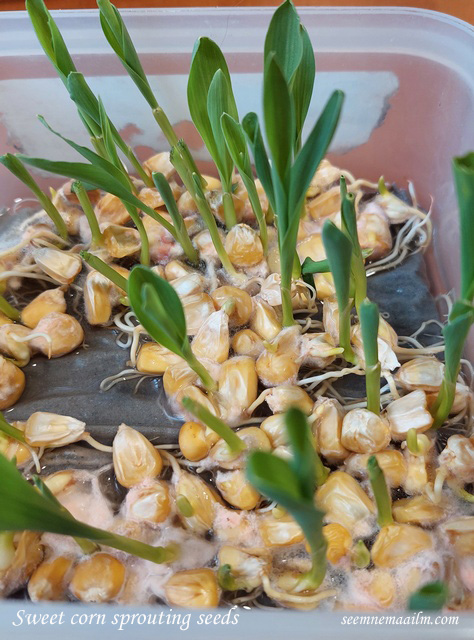Ex Tax: 1.85€
Young corn sprouts are very tasty and tender - an unusually healthy delicacy!
Ideally for salads, sandwiches, omelets and soups. They can be eaten raw or cooked.
Rich source of vitamins: A, B3 and C, as well as calcium, iron, magnesium and zinc.
Instructions for use:
Pour the amount reguired in to a bowl of water at room temperature and allow them to soak for 8-10 hours.
Subsequently place the seeds into your sprouter covering no more than 25% of the tray as the seeds will in size. Put the sprouter in a light spot at room temperature changing the water 2-3 times a day.
The sprouts will be ready in about 6-10 days. Cut the sprouts about the seed and wash them before eating. They will keep in the fridge for up to a week (8-10 days).

At home, you can grow corn microgreens, which grow quickly and have a sweet taste. This will enrich your diet with vitamins and useful microelements. The transformation of a small handful of grains into fresh shoots takes less than 7 days and will be a great addition to your daily menu. For this, it is recommended to use ordinary soil for seedlings or a special mat. Microgreens have useful properties, which consist in the fact that they contain much more nutrients and vitamins than adult plants of the same crop. This is due to the fact that the greens are cut off when young and their shoots retain the maximum of useful components accumulated from the seeds. Thanks to this, the body receives a large dose of vitamins A, B, C, E, as well as iron, calcium, magnesium and phosphorus. At the same time, microgreen shoots are a source of fiber and protein. To effectively germinate corn microgreens, you need to make the right choice of planting material. Organic corn seeds are the best solution, as they are not treated with chemicals for pests. If you use inorganic seeds, there is a chance that they will germinate poorly, and they are also less useful.
To determine the number of seeds, you need to take into account the size of the container and the planned volume of receipt (do not forget that when sowing corn, you need to place the seeds at a small distance from each other, at least 0.2-0.5 cm).
Any nutritious soil for seedlings or indoor plants is suitable for growing corn. Buying a special substrate or professional soil is not necessary. When choosing a container, you can also save money. It is important to remember about several drainage holes in the bottom, otherwise the seedlings risk becoming moldy or starting to rot.
In order to get sprouts faster, you need to soften the corn seeds before planting. To do this, soak them in ordinary water at room temperature for a day, its level should rise above the seeds by 2 cm. During this time, the seeds will swell and soften, absorbing a sufficient amount of moisture, which will prepare them for planting. Using this simple life hack, you can significantly reduce the time it takes to grow fresh corn microgreens, which will be on average 7-12 days.
To speed up the germination process, the crops should be kept in a warm and dark place. The first small leaves will appear on average within 3 days. After this, you need to remove the lid from the container.
It is important to carefully water the beds as needed. Do not overdo it when the top layer of soil dries out. At the growth stage, it is undesirable for young crops to be exposed to direct sunlight.
Experts recommend leaving the shoots in a dark place. Photosynthesis and chlorophyll production begin when corn shoots are exposed to sunlight. In bright sunlight, the sprouts will be bright green and will have a bitter taste and fibrous consistency. To get tasty and healthy light yellow leaves, you should find a dark place for the containers with microgreens. Corn microgreens require minimal care, you just need to maintain the right level of humidity and temperature. You don't need to buy special phytolamps, as is the case with other types of microgreens.
You can harvest the greens either whole or by gradually trimming them. The shoots should be carefully cut off as soon as the plants stretch out to an average of 5-7 cm. It is important to remember that you shouldn't wait too long before harvesting, as sprouts taller than 10 cm become coarse and bitter in taste.
Uneven growth of crops can become a problem in the process. Possible causes of this may be a lack of nutrition, improperly selected temperature for germination, use of cold soil or watering with low-quality water.
What other problems can arise when growing microgreens:
If the sprouts have wilted and the leaves look wilted, this may be due to a lack of moisture or overwatering.
If the microgreens smell bad, this may be a sign of mold or bacteria. Normally, microgreens should have a slight fresh smell.
If there are obvious signs of mold, then you should throw away the container and disinfect the substrate before reusing. If the problem recurs, then you need to adjust the watering schedule and use a container with drainage holes.
If corn microgreens are growing in light shade, uneven growth may occur, when the sprouts on one side of the container are longer and larger than on the other side. In this case, you can easily turn the tray to the other side.
Yellow leaves on corn microgreens are normal, and there is no need to move the containers closer to the light.
If the first sprouts do not appear within 3-5 days after sowing the seeds, this may be due to poor quality seed material or improper soaking.
Before using cut corn microgreens for food, they must be thoroughly washed in cold water. This is an additive that goes well with omelettes, meat and pizza, and can complement almost any dish.












